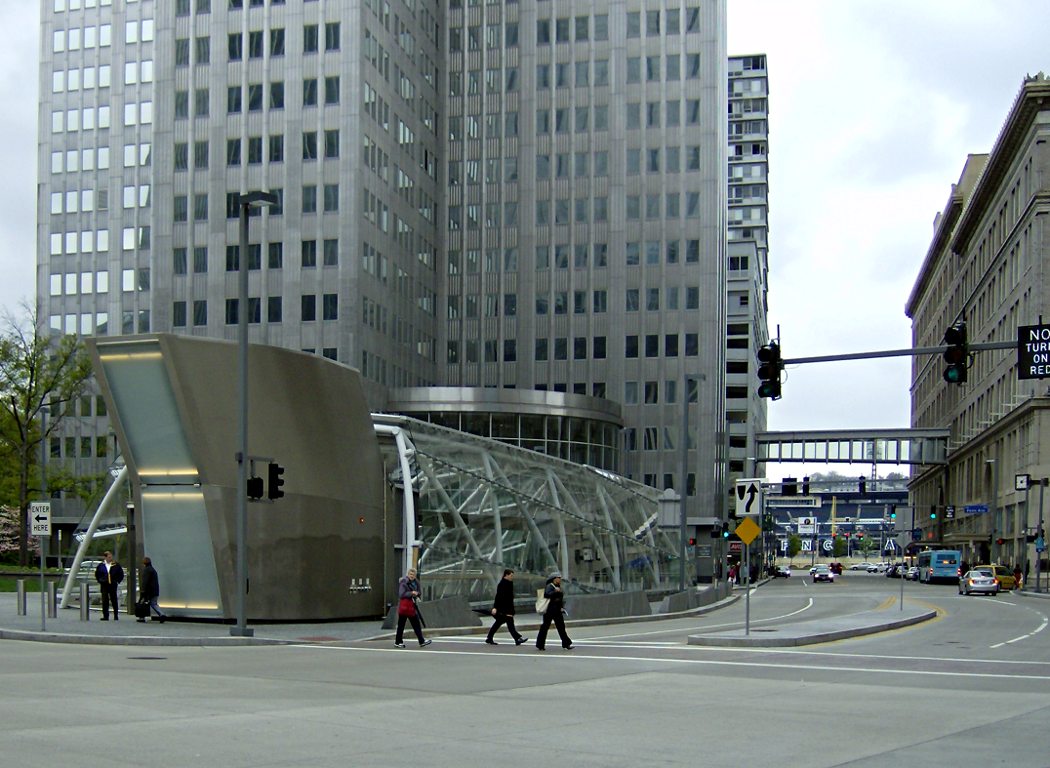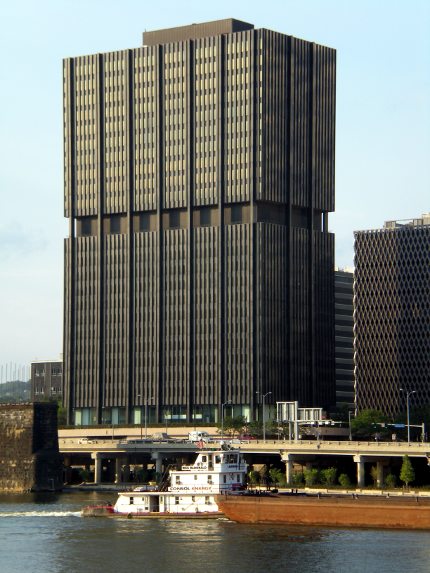The Diamond Biulding, at Fifth and Liberty Avenues, is a curiously shaped irregular pentagon, one of the many buildings forced into odd shapes by the colliding grids along Liberty Avenue. Except for the shape, it’s a fairly standard beaux-arts tower, with base, shaft, and cap, and an exuberant bronze cornice at the very top. The building was designed by MacClure and Spahr, a Pittsburgh firm that gave us several other distinguished buildings, including the Union National Bank building on Fourth Avenue.
-
Diamond Building
-
Gateway Station, Above the Ground
The part of the new Gateway subway station that projects above the ground is a weirdly surrealistic pile of glass that will probably look “futuristic” far into the future, in that wonderfully hokey way that old Flash Gordon serials still look “futuristic” today. This is meant as a compliment. Most trends in architecture look terribly dated a few years later, but the most outrageous Art Deco or Space-Age creations never look stale, even when we can hardly believe that they ever actually got built. The multiple angles of the glass reflect the surrounding buildings in a wild cacophony of fractured images. The architects have succeeded in creating a station that Pittsburghers will want to show off to visitors, and that we will enjoy using ourselves.
-
The Arlington
In general, Pittsburgh apartment buildings can be small and elegant or large and atrocious, but Shadyside is one of the few neighborhoods in Pittsburgh where apartment buildings can be both large and elegant. The Arlington, at the corner of Centre Avenue and Aiken Avenue, is one of the most elegant of the lot. Here we see the Aiken Avenue side. The various room layouts are rather charmingly named for composers, Bartok being the cheapest and Sibelius the most expensive. If you wish to occupy a spare hour or two, try to come up with a critical theory that accounts for that pricing.
-
Buhl Building
-
Westinghouse Building
-
American Fascist
A certain C. C. Ehrhardt, a name that seems familiar for some reason, writes:
Dear old Pa Pitt, please explain what you mean by American Fascist.
Father Pitt is glad to oblige.
The architecture of Hitler’s Germany is famous, or notorious, for its grandiose scale and imitation of Roman imperial ideals. But it was part of a wider worldwide style in governmental architecture. Adapting classical forms to twentieth-century needs, the style conveyed the idea that your government is all-powerful and benevolent—but all-powerful first, benevolent a distant second. We might call the style “fascist” in the root sense of the term, the fasces being an ancient Roman symbol of authority.
When this style appears in the United States, old Pa Pitt can think of no better term for it than “American Fascist.” The most prominent example in Pittsburgh is the Federal Building on Grant Street:
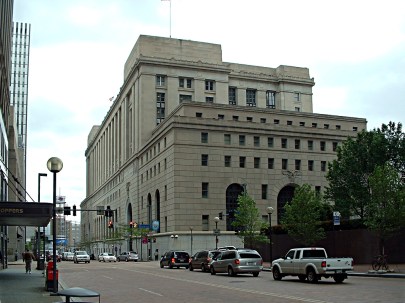
Not only does this massive building strongly echo the parallel developments that would grow up in Nazi Germany, but over each entrance it even carries the very symbol of Fascism, the fasces, a bundle of rods surrounding an axe:
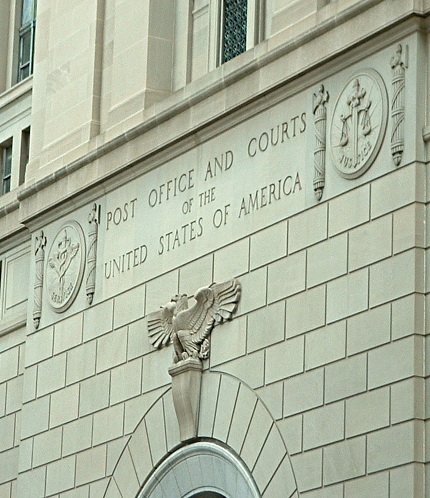
This is the most nakedly Fascist building in Pittsburgh, but there’s more than a little of the style on some other government buildings of the same period. The County Office Building, for example, has a strong whiff of the Fascist about it, although uniquely its architectural inspiration is not classical Roman but medieval Romanesque:
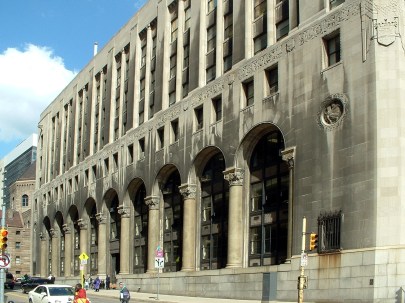
The choice of Romanesque style might seem surprising, but the urban context makes the reason clear. H. H. Richardson’s gigantic courthouse and jail sits right across the street; “Richardsonian Romanesque” became the official architectural style of Allegheny County, and even the strong current of fascism in middle-twentieth-century government architecture would have to take Richardson’s influence into account.
-
Federal Deco
-
Benedum-Trees Building

The top of the Benedum-Trees Building, one of the famous bank towers that made Fourth Avenue one of the wonders of the world at the very beginning of the age of skyscrapers. The Fourth Avenue historic district is a few blocks’ walk from the Steel Plaza subway station.
-
One Mellon Center

The octagonal tower of One Mellon Center, Pittsburgh’s second-tallest building, seen from the intersection of Seventh Avenue and Grant Street. In the foreground at left is the dramatic base of the U. S. Steel Tower, whose colossal bulk is supported on impossibly spindly piers, defying gravity like something from the imagination of Rene Magritte. (From a distance, the building strikes old Pa Pitt as pedestrian, but the lobby and mezzanine are dramatic.) At right is the base of the Koppers Building.
-
Ober House in Troy Hill
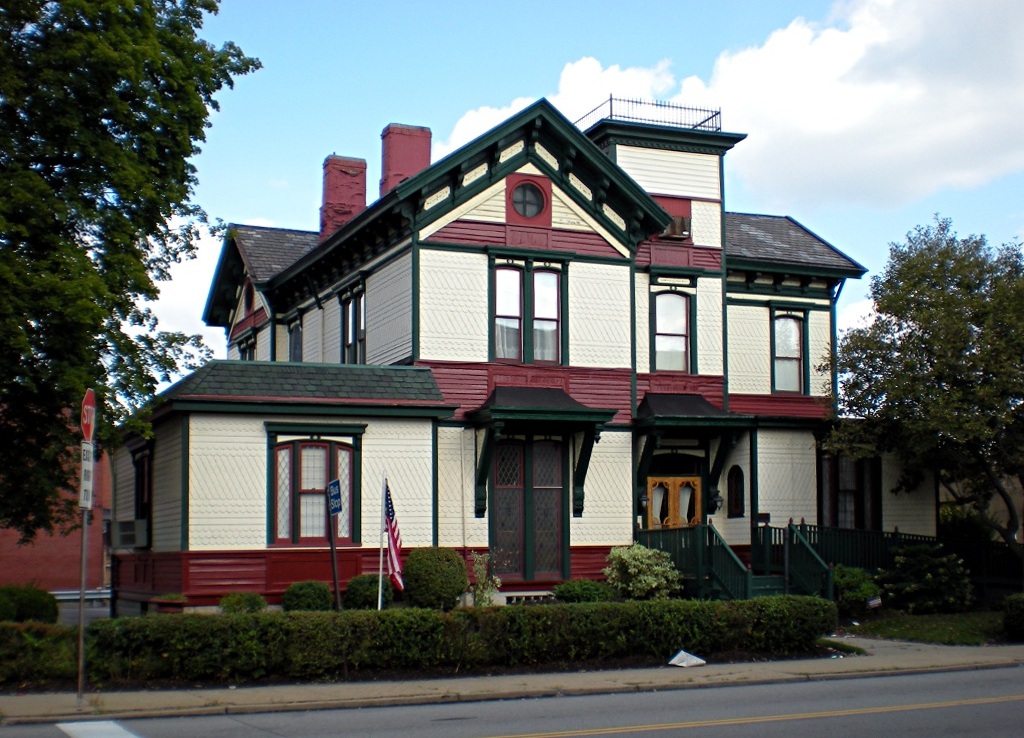
A rare “Stick Style” Victorian, this was the home of Mr. J. P. Ober of Eberhardt & Ober. The style was common elsewhere in the country, but Pittsburgh preferred heavier, stonier styles in its domestic architecture. As commonly happens to an opulent house in a working-class neighborhood, this has become a funeral home.




